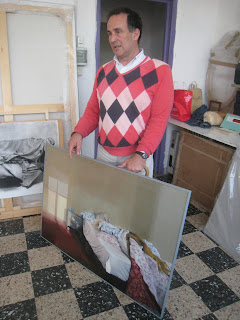 |
| Silvia Codignola was the first artist at Piano Creativo, and the only one of the original artists still there. |
 |
| Discussing their work with Luis Serrano, Flavia Dodi and Sonia Cipollari - in Serrano's bright studio |
On a Tuesday morning in June, six of the artists gave us some background on the artists' studios on one floor of a school, showed us their studios and many of their works - done and in process, and made us coffee. What more can one ask?
 |
| The 1950s school building that hosts the artists' studios. |
The artists generally (the exception is interesting and noted below) have not known each other before renting studios in the building, and only occasionally show their work together - one or two "open studios" each year. The artists tend to come and go over time. The building was built as a school on private land owned by the Tozzi family- their "tenuta," or semi- rural land holdings in this southwest corner of suburban Rome. It's an unusual early-1950s structure with enormous glass windows that are ideal for artists' studios, and interesting, given that the school was once a school for the blind. In the '90s, with less demand for school space, some of the building was re-purposed; part of one floor was designated artists' studios. Rent is reasonable - Euro 500-600/month for one studio, and the studios usually are shared by 2-3 artists. There are a dozen artists now, and 8 studios. As the photos reveal, the studios range from clean and well-organized to crowded and rather messy, what one would expect from a group of artists.
 |
| Serrano with one of his "Bedding" series. |
As Sonia Cipollari and Luis Serrano explained to us, almost all of the artists here have no other jobs and work hard all day, 5-6 days/ week, at their studios. Historically, artists' studios were once on via Margutta, near the Spanish Steps, as portrayed in Roman Holiday and where the rents went sky-high as early as post WWII. Then artists moved to other areas, such as San Lorenzo. But artists now tend to be in collectives on the outskirts of Rome, such as Portonaccio, about which we wrote last year, and this area, at the outer end of Monteverde Nuovo.
Sonia described the "golden age" of contemporary art, in the late '90s until about 2003, when the City funded studios and shows. No longer. Now, we have heard, artists who want shows usually have to pay for the space, the opening party, the publicity, the catalog; something few contemporary artists can afford.
 |
| Cipollari showing her water color technique. |
Now artists depend on cultural institutions, such as Temple University's Rome campus, where Shara Wasserman has curated shows of independent artists, including this group. Wassernman, who now has her own Web site, is perhaps the most knowledgeable curator of contemporary art in Rome.
 |
| Dodi describing her chromatic approach. |
And, of course, to the art: all of the work we saw at Piano Creativo was of a high level. Luis Serrano showed us work from a recent show, "Bedding." Flavia Dodi explained her mysterious paintings, some in black and white, others in "beautiful" color. We sensed she prefers her more monochromatic pieces. Marcello Toma works with machinery and gears, in a neo-realist, post-Futurist vein, while his studio mate, Stefano Bolcato is using children's toy pieces (listen up, Fisher Price) to explore themes such as domestic violence and homosexuality. Sonia Cipollari works in the difficult medium of watercolor on somewhat slick, slightly transparent paper, making her fascinating projects time-consuming, she told us. We were particularly drawn to Silvia Codignola's sculpture and paintings, the latter evocative of the existential themes and styles of the 1930s and of the California work of David Hockney.. She uses a type of manikin figure to portray domestic scenes.
 |
| Toma and work in process. |
 |
| Cipollari shows photos of the sets for HBO's Rome series. |
The exception noted above to the artists knowing each other before renting studios here is a group of 3 who worked together painting interior walls and ceilings, both de novo and restorations. They had a successful project painting the Cinecitta' sets for the HBO Rome US TV series.
The artists at Piano Creativo are open to visits. We suggest going during a weekday, perhaps between 10 a.m. and 5 p.m. Take Tram 8 (now beginning at Largo di Torre Argentina, but shortly to begin at Piazza Venezia) to Casaletto (end of the line).
Immediately on the right, at No. 420 viale Gianicolense, access "artisti" on the citofono by using the up and down arrows, and then press the bell sign below. There's an elevator: they are on floor "2" , but 3 floors up, because you start on floor 1. The Web site is: http://pianocreativo420.blogspot.it/. There are links there to the individual artists' Web sites as well.
 |
| Bolcato points out the "wedding portrait" tipped over in his scene of domestic violence. |

Title: Artists' Colonies in Rome, Part 2: Piano Creativo ("Creative Floor")
Rating: 100% based on 99998 ratings. 5 user reviews.
Author 12:30 AM
Rating: 100% based on 99998 ratings. 5 user reviews.
Author 12:30 AM






